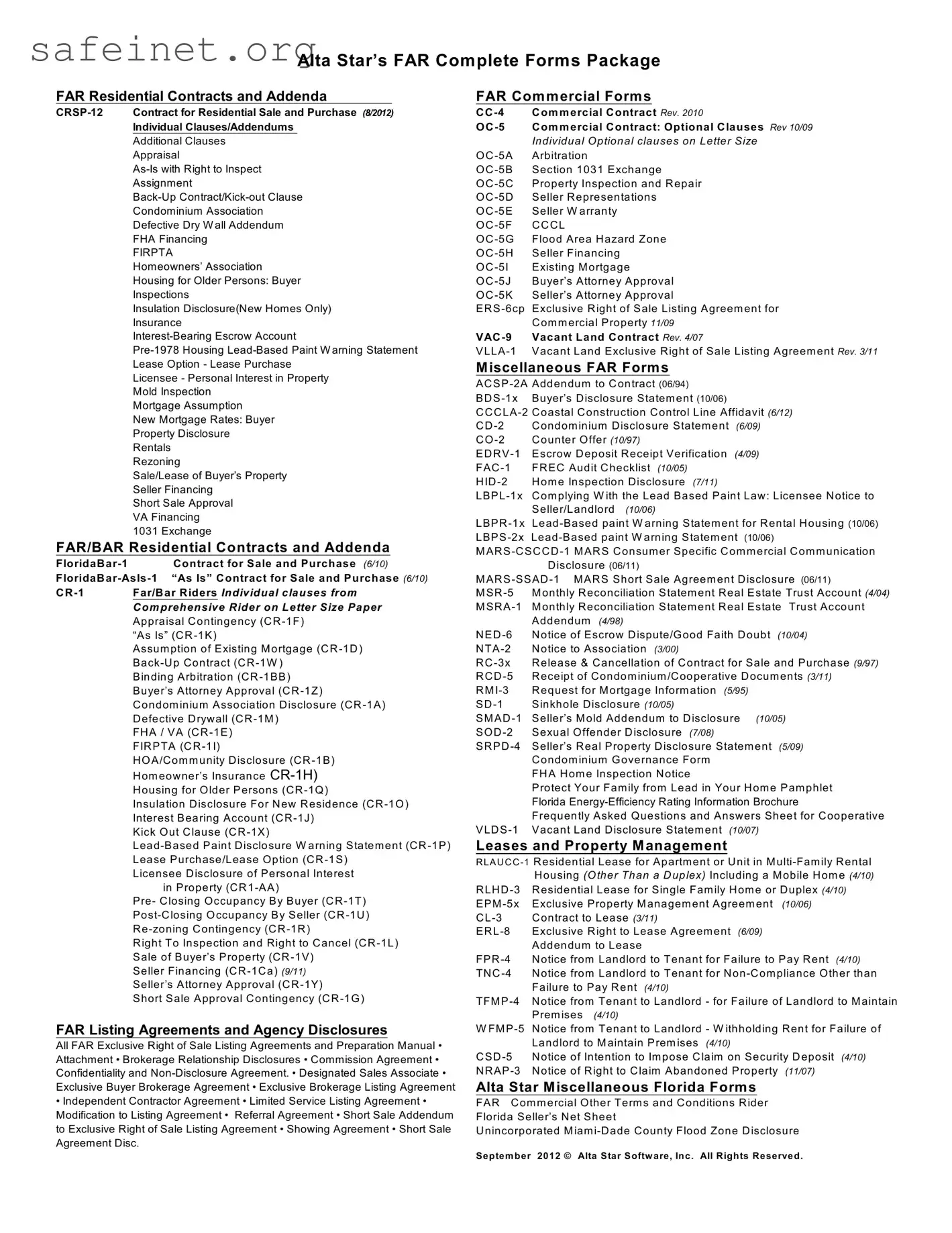FAR Residential Contracts and Addenda
CRSP-12 Contract for Residential Sale and Purchase (8/2012)
Individual Clauses/Addendums
Additional Clauses Appraisal
As-Is with Right to Inspect Assignment
Back-Up Contract/Kick-out Clause Condominium Association Defective Dry Wall Addendum FHA Financing
FIRPTA
Homeowners’ Association Housing for Older Persons: Buyer Inspections
Insulation Disclosure(New Homes Only) Insurance
Interest-Bearing Escrow Account
Pre-1978 Housing Lead-Based Paint Warning Statement Lease Option - Lease Purchase
Licensee - Personal Interest in Property Mold Inspection
Mortgage Assumption
New Mortgage Rates: Buyer Property Disclosure Rentals
Rezoning
Sale/Lease of Buyer’s Property Seller Financing
Short Sale Approval VA Financing
1031 Exchange
FAR/BAR Residential Contracts and Addenda
FloridaBar-1 Contract for Sale and Purchase (6/10) FloridaBar-AsIs-1 “As Is” Contract for Sale and Purchase (6/10)
CR-1 Far/Bar Riders Individual clauses from Comprehensive Rider on Letter Size Paper
Appraisal Contingency (CR-1F) “As Is” (CR-1K)
Assumption of Existing Mortgage (CR-1D) Back-Up Contract (CR-1W )
Binding Arbitration (CR-1BB) Buyer’s Attorney Approval (CR-1Z) Condominium Association Disclosure (CR-1A) Defective Drywall (CR-1M)
FHA / VA (CR-1E)
FIRPTA (CR-1I)
HOA/Community Disclosure (CR-1B) Homeowner’s Insurance CR-1H) Housing for Older Persons (CR-1Q)
Insulation Disclosure For New Residence (CR-1O) Interest Bearing Account (CR-1J)
Kick Out Clause (CR-1X)
Lead-Based Paint Disclosure W arning Statement (CR-1P) Lease Purchase/Lease Option (CR-1S)
Licensee Disclosure of Personal Interest in Property (CR1-AA)
Pre- Closing Occupancy By Buyer (CR-1T)
Post-Closing Occupancy By Seller (CR-1U) Re-zoning Contingency (CR-1R)
Right To Inspection and Right to Cancel (CR-1L) Sale of Buyer’s Property (CR-1V)
Seller Financing (CR-1Ca) (9/11) Seller’s Attorney Approval (CR-1Y)
Short Sale Approval Contingency (CR-1G)
FAR Listing Agreements and Agency Disclosures
All FAR Exclusive Right of Sale Listing Agreements and Preparation Manual • Attachment • Brokerage Relationship Disclosures • Commission Agreement • Confidentiality and Non-Disclosure Agreement. • Designated Sales Associate • Exclusive Buyer Brokerage Agreement • Exclusive Brokerage Listing Agreement
• Independent Contractor Agreement • Limited Service Listing Agreement • Modification to Listing Agreement • Referral Agreement • Short Sale Addendum to Exclusive Right of Sale Listing Agreement • Showing Agreement • Short Sale Agreement Disc.
FAR Commercial Forms
CC-4 |
Commercial Contract Rev. 2010 |
|
OC-5 |
Commercial Contract: Optional Clauses Rev 10/09 |
|
Individual Optional clauses on Letter Size |
OC-5A |
Arbitration |
|
OC-5B |
Section 1031 Exchange |
|
OC-5C |
Property Inspection and Repair |
|
OC-5D |
Seller Representations |
|
OC-5E |
Seller W arranty |
|
OC-5F |
CCCL |
|
OC-5G |
Flood Area Hazard Zone |
|
OC-5H |
Seller Financing |
|
OC-5I |
Existing Mortgage |
|
OC-5J |
Buyer’s Attorney Approval |
|
OC-5K |
Seller’s Attorney Approval |
|
ERS-6cp |
Exclusive Right of Sale Listing Agreement for |
|
Commercial Property 11/09 |
|
VAC-9 |
Vacant Land Contract Rev. 4/07 |
|
VLLA-1 |
Vacant Land Exclusive Right of Sale Listing Agreement Rev. 3/11 |
Miscellaneous FAR Forms |
|
ACSP-2A |
Addendum to Contract (06/94) |
|
BDS-1x |
Buyer’s Disclosure Statement (10/06) |
|
CCCLA-2 |
Coastal Construction Control Line Affidavit (6/12) |
CD-2 |
Condominium Disclosure Statement |
(6/09) |
CO-2 |
Counter Offer (10/97) |
|
EDRV-1 |
Escrow Deposit Receipt Verification |
(4/09) |
FAC-1 |
FREC Audit Checklist (10/05) |
|
HID-2 |
Home Inspection Disclosure (7/11) |
|
LBPL-1x |
Complying W ith the Lead Based Paint Law: Licensee Notice to |
|
Seller/Landlord (10/06) |
|
LBPR-1x |
Lead-Based paint W arning Statement for Rental Housing (10/06) |
LBPS-2x |
Lead-Based paint W arning Statement (10/06) |
MARS-CSCCD-1 MARS Consumer Specific Commercial Communication |
|
Disclosure (06/11) |
|
MARS-SSAD-1 MARS Short Sale Agreement Disclosure (06/11) |
MSR-5 |
Monthly Reconciliation Statement Real Estate Trust Account (4/04) |
MSRA-1 |
Monthly Reconciliation Statement Real Estate Trust Account |
|
Addendum (4/98) |
|
NED-6 |
Notice of Escrow Dispute/Good Faith Doubt (10/04) |
NTA-2 |
Notice to Association (3/00) |
|
RC-3x |
Release & Cancellation of Contract for Sale and Purchase (9/97) |
RCD-5 |
Receipt of Condominium/Cooperative Documents (3/11) |
RMI-3 |
Request for Mortgage Information (5/95) |
SD-1 |
Sinkhole Disclosure (10/05) |
|
SMAD-1 |
Seller’s Mold Addendum to Disclosure (10/05) |
SOD-2 |
Sexual Offender Disclosure (7/08) |
|
SRPD-4 |
Seller’s Real Property Disclosure Statement (5/09) |
|
Condominium Governance Form |
|
|
FHA Home Inspection Notice |
|
|
Protect Your Family from Lead in Your Home Pamphlet |
|
Florida Energy-Efficiency Rating Information Brochure |
|
Frequently Asked Questions and Answers Sheet for Cooperative |
VLDS-1 |
Vacant Land Disclosure Statement |
(10/07) |
Leases and Property Management
RLAUCC-1 Residential Lease for Apartment or Unit in Multi-Family Rental
|
Housing (Other Than a Duplex) Including a Mobile Home (4/10) |
RLHD-3 |
Residential Lease for Single Family Home or Duplex (4/10) |
EPM-5x |
Exclusive Property Management Agreement (10/06) |
CL-3 |
Contract to Lease (3/11) |
ERL-8 |
Exclusive Right to Lease Agreement (6/09) |
|
Addendum to Lease |
FPR-4 |
Notice from Landlord to Tenant for Failure to Pay Rent (4/10) |
TNC-4 |
Notice from Landlord to Tenant for Non-Compliance Other than |
|
Failure to Pay Rent (4/10) |
TFMP-4 Notice from Tenant to Landlord - for Failure of Landlord to Maintain Premises (4/10)
W FMP-5 Notice from Tenant to Landlord - W ithholding Rent for Failure of Landlord to Maintain Premises (4/10)
CSD-5 Notice of Intention to Impose Claim on Security Deposit (4/10) NRAP-3 Notice of Right to Claim Abandoned Property (11/07)
Alta Star Miscellaneous Florida Forms
FAR Commercial Other Terms and Conditions Rider Florida Seller’s Net Sheet
Unincorporated Miami-Dade County Flood Zone Disclosure

